"In a surprise to some members of the advanced networking community in the U.S., artists are clamoring to use high-bandwidth networks to explore whether there are spatial limits to art. At the same time, these artists seem to be puzzling out the relationship of humanity to technology."
—Bob Bellandi
NYSERNet Network
Imagine yourself in Orlando, Florida, or in Peoria, Illinois, sitting in a distance learning classroom or video conference center on a university campus, watching a live adaptation of Sophocles’ Antigone. In Orlando, Antigone (the character) is in the room with you as you watch a projection of King Creon. In Peoria, the projection shows Antigone, while King Creon is physically in the room with you. As an observer of this performance, you are part of the Bradley University–University of Central Florida Dynamic Media Project—a live, interactive, long-distance theatrical piece that conveys the story using Internet2.
Our experiments with long-distance arts collaboration in a multiform environment began in July 2002. According to Janet H. Murray’s Hamlet on the Holodeck: The Future of Narrative in Cyberspace,1 multiform is defined as "… a written or dramatic narrative that presents a single situation or plotline in multiple versions, versions that would be mutually exclusive in our ordinary experience." We consider a multiform environment to be an interactive environment where different audiences experience a shared event from different and mutually exclusive frames of reference.
Our Dynamic Media Project team members had extensive experience as performers, directors, and playwrights, but none of us had experience creating a multiform project. We expected to learn many things during our experiments with multiform, but we sought to answer one primary question: could we maintain story clarity and message for our audiences in a live, long-distance, multiform environment?
Someone asked us to articulate why we, as theatre artists, felt we had anything to offer an emerging technical field. The question surprised us. Major innovations in technology have always changed the way people produce and consume the arts. From electricity and hydraulics to film and computers, the art of storytelling and entertainment has used and explored new uses for nearly all technological advances that increase communication, move objects, and capture or direct light. During recorded history, theater artists have conveyed complex messages with available technologies for the purposes of politics, religion, education, sales, and entertainment. Whatever the technical advance, it is always human relationships and the human ability to interact and interpret that makes science relevant. We felt we were in our element—not interlopers—as we began to plan and develop the Dynamic Media Project.
Methodology
Our team chose to adapt Antigone by Sophocles because it is one of humanity’s oldest and most time-tested stories. It has played successfully to audiences in traditional performance venues for more than 2,000 years. This means that any lack of clarity perceived by our audiences would be the fault of the new medium or the production team, not the basic story. A perception of clarity from our audiences would prove the viability of creative collaboration via Internet2.
To test the success of our staging, we prepared research questionnaires in consultation with the University of Central Florida’s (UCF) Research Initiative for Teaching Effectiveness to maintain the integrity of the collected data. The questionnaires were distributed to audience members by costumed actors at both live sites. These actors were dressed as contemporary diplomats and military personnel who asked for invitations and I.D. and generally treated the audience as governmental V.I.P.s summoned by their government just after a civil war (see Figure 1). The questionnaires were presented as a governmental briefing packet with the research questions sealed and stamped "Secret—Do Not Open." Immediately after the Internet2 connection was terminated, the same actors who met the audience at the door asked them to open these packets and answer the enclosed questions.
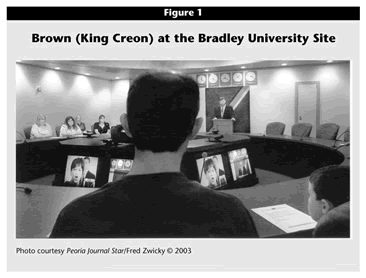
Click image for larger view.
A third site experienced the event as a canned broadcast. The audience viewed a non-interactive DVD as a split-screen projection at a later date in Orlando, thus serving as a control group. This audience was asked to respond to the story shown in a classroom, receiving their research questionnaires at the end of the presentation from a team member rather than costumed actors.
Remarkably, we received a 100 percent response from all three sites. We believe this indicates unique interest in the experiment. One audience member at the live Orlando event contacted us later to thank us for "the exciting conversations" she had had with colleagues after the performance. She said they talked for some time about the possible new applications of technology-enhanced collaborations.
Getting Started
When we started, we first looked around for other long-distance performance projects and quickly discovered a significant number of music projects on the Internet. But audio requires less bandwidth than video. This meant that theater risked larger signal delay and more frequent signal interruptions than music because of the higher bandwidth required for streaming video. Most theater art events we found on the Web were streamed performance feeds, no different from canned events or traditional broadcasting, with two notable exceptions: The Technophobe and the Madman and Dancing Beyond Boundaries.
The Technophobe and the Madman, directed by Don Ritter and performed in February 2001, was a collaboration between New York University and Rensselaer Polytechnic Institute. This production piece is now recognized as the first Internet2 live distributed musical (http://aesthetic-machinery.com/technophobe.html). Because the audio, video, and digital mixing of the event was clearly the focus of the experimentation, we did not choose it as our model. We wanted to focus on the clarity of storytelling in a resource-accessible environment so that we could repeat and share our work.
Another factor differentiating that project from ours was distance. The distance between the stages used in The Technophobe and the Madman performance was 160 miles; the distance between Orlando and Peoria is 966 miles. The potential for signal degradation can increase with distance. We felt we had enough reasons to continue our research.
We then found The Digital World Institute’s Dancing Beyond Boundaries, a collaborative project directed by James Oliverio in a partnership among the University of Florida; the University of Minnesota, Twin Cities; and the University of Campinas in Brazil. This event more closely resembled the exchange we imagined: real-time, interactive, and multi-site (more than two), with distance and the potential for realistic verbal exchange. (View the performance at <http:://www.digitalworlds.ufl.edu/projects/dbb/Default.asp>.) We viewed the real-time streamed "how to" presentation by key technical staff of Dancing Beyond Boundaries. As a result, we realized we needed to create a project unique to our circumstances. Four discoveries were important to us:
- We solidified our desire to make our work useful to other educational institutions in an immediate, practical, and accessible way.
- The Dancing Beyond Boundaries project was not replicable for most educational institutions due to the human resources required. The project used 125 artists and engineers.
- The Dancing Beyond Boundaries project was not replicable for most educational institutions due to the fiscal resources required. Our estimate for the equipment used by the Dancing Beyond Boundaries team exceeded $100,000.
- We confirmed that outside campus partnerships beyond our own discipline were necessary.
We began to visualize how our project might work, but we needed to gather the resources to make the experiment possible. The way to do this was to seek institutional support and cross-departmental collaboration on both campuses.
Institutional Support
The process for obtaining institutional support was similar to that for finding a compatible project partner. The Bradley and UCF theater departments had each sought a partner with shared goals and compatible leadership. Personal relationships and trust between our project leaders had been developed in professional venues outside our universities, and the goals of both departments included an exploration of human interaction and interpretation of relationships through enhanced technologies. Similarly, we built on the trust our respective administrations had in us, linking our universities’ missions and goals to our project goals.
When team co-director George Brown approached Jeffrey H. Huberman, Dean of the Slane College of Communication and Fine Arts at Bradley, he cited the university’s mission statement:
John Shafer found that UCF’s Dynamic Media Initiative encouraged experimentation:
Bradley’s Huberman and UCF’s Terry Frederick, Associate Dean of the College of Arts and Sciences and Interim Director of the School of Film and Digital Media, gave the green light to proceed. Because the project was new and intriguing, people from different departments on both campuses were eager to participate. We took advantage of the enthusiasm to gain access to facilities and creative talent like the two people in Figure 2. Actress Danielle Marino (left), a theater BFA student, played the character of Antigone in the high-tech production of the play, while Don Merritt provided technical expertise.
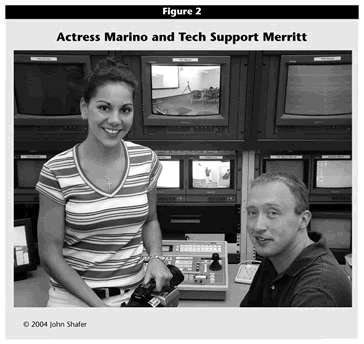
Click image for larger view.
Institutional Differences
Once we had obtained support for our project, we had to address the two institutions’ disparate decision-making processes. Upper-level administrative personnel drove Bradley’s active project leadership, while an assistant professor spearheaded UCF’s leadership. Bradley is a private Masters I institution with an enrollment of approximately 6,000 students. UCF is a public doctoral/research intensive institution with more than 42,000 students.
These infrastructure differences created different administrative needs and resulted in significant differences in infrastructure between the two universities. These infrastructures affected our expectations of each other and occasionally frustrated our perceptions of progress and communication. A frank discussion about the different challenges encountered yielded the necessary understanding.
In addition, because of the long-distance nature of our collaboration, we encountered a situation we eventually termed "communication drift." Days would pass without contact as we awaited approval, scheduling, or action from our many partners. A slightly different interpretation of a single sentence often sent us "drifting" in different directions. The project leaders had never encountered this situation while working together in the past. Once rehearsals began and Peoria and Orlando could see and talk to each other through the Internet2 connection, communication drift ceased.
Creating Partnerships and Exploring Resources
The team decided that John Shafer would serve as project director from Orlando and George Brown would serve as co-director and actor from Peoria. Additionally, UCF created an experimental space in Orlando that allowed the UCF team to play with images and project sound from one room to another in a simulation of the anticipated performance environment. This step gave us valuable experience before actually executing the creative work. UCF students from I-Play, an improvisation troupe dedicated to new media, happily volunteered to test the equipment. To achieve this capability, the UCF Theatre Department pursued a $2,000 Classroom Improvement Grant. This grant provided the financing to hardwire a flexible, multiuse audio/video system into one of the existing classrooms.
Another UCF grant, a $2,000 Burnett Honors College Grant for Undergraduate Research, brought us the participation of Danielle Marino (see Figure 2). We enrolled her in a Directed Independent Research class and teamed her with UCF’s Research Initiative for Teaching Effectiveness to create the research instrument that we used to record data. The UCF Office of Instructional Resources, the Faculty Center for Teaching and Learning, and the departments of Digital Media and Theatre all contributed valuable assistance.
On the Bradley side, a National Science Foundation grant in September 2001 provided ample physical resources. According to Stan Liberty, Provost and Vice President for Academic Affairs,
Collaboration among four campus offices—the Office of Information Resources and Technology, the Academic and Technology Support Unit, Slane College of Communication and Fine Arts, and Department of Theatre Arts—was highly effective. Additionally, personnel from the Communications and Engineering Support Unit and the Department of Communications provided technical assistance.
Physical Interaction
The only physical interaction between Orlando and Peoria occurred when John Shafer and Be Boyd traveled to the Bradley Campus in May 2003 to continue project development and to experiment with the different interactive realities.
The photo in Figure 3 was taken while Shafer, Brown, and Boyd were at the Bradley site. At the same time, Marino at the UCF site experimented with multiform perspective in Internet2 with Jeff Wirth, Assistant Professor of Film at UCF.
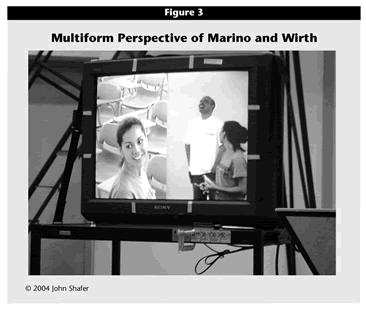
Click image for larger view.
Creating and Selecting Text: a Multiform Environment
We discovered that the long-distance environment provided interesting and unique challenges. Normally, a writer/director creates for a single audience with a single point of reference, and audiences experience roughly the same event. This would be true even in the case of cinema or broadcast game shows because these events assume a roughly identical viewing perspective.
In the multiform environment of our project, different audiences would experience a shared event from different and exclusive frames of reference. Audiences experience different parts of the ongoing "reality" of the story depending on their location and when they see the presentation. The experience would be shared but inherently different depending on when and where it was seen. For example, in Figure 4, actor Mark Brotherton (left) in Orlando performs with George Brown (King Creon) in Peoria. The king has just been informed of the death of Antigone and his son. Obviously, the perspective would be quite different if you were sitting in Peoria, just a few feet away from Creon.
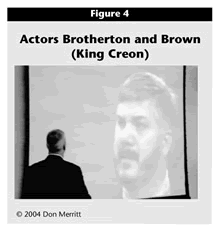
Click image for larger view.
The multiform nature of the experiment was singular, exciting, and challenging. Shafer, Marino, Brown, and Boyd adapted and shortened the script of Antigone to The Antigone Experiment so that the audience and the technology were an integral part of the action. The audience was told they were in Thebes (Peoria) or near the battlefield (Orlando), at the end of a civil war. They were told they had been invited to a teleconferenced public briefing with their new leader. This allowed us to keep the cameras, monitors, and machinery in full view.2 Since we were moving the timeframe of the story to the present, the costumes were contemporary reflections of the characters’ roles.
When signal dependability became a serious issue, the team incorporated signal quality into the story line so that it complemented the atmosphere of a high-level long-distance briefing. Actor-technicians at both sites were prepared to jump in and participate in a planned improvisation should we lose the signal. The quality of the signal was usually quite high, but during times of heavy local Internet traffic, the system froze, jumped, and sometimes disconnected. We found it impossible to accurately predict when the highest traffic would occur.
As a result of what we learned during this project, UCF later made some infrastructure changes that seem to have reduced these problems. The videoconference system was connected directly to the university’s network backbone, bypassing all the network traffic in the building, and quality-of-service changes were made in the network. These modifications significantly reduced the network errors and associated video interruptions.
The Research
The team surveyed those attending the performances at all three locations. We obtained feedback from 28 people at UCF, 33 at Bradley, and 62 at the control site. The research document contained questions regarding simple facts like audience members’ age, sex, and profession. There were also opinion-based questions measured according to a set of standard responses. A few open questions gave them the opportunity to respond in their own words.
One question asked "Would you be interested in seeing this kind of performance in the future?" More than three-fourths of both the Peoria and Orlando audiences said yes, while at the control site, a little more than half responded favorably about attending similar performances in the future (see Table 1). A 41-year-old Bradley audience member applauded the "bold merging of artistry and technology," while comments like the following from a 19-year-old man in the Orlando control group were more common: "Something about the piece was not connecting with me as an audience member."
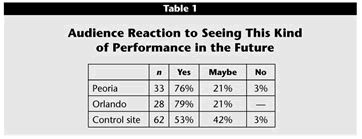
Click image for larger view.
Table 2 shows the response to the question "Was the story clear and connected?" Audience members who experienced the interactive version felt that the story was clear and connected and that the experiments succeeded in merging technology with live performance. The control group was less satisfied.
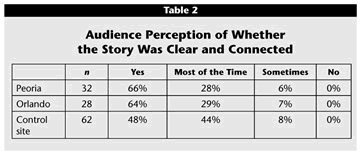
Click image for larger view.
For some insight into the results, consider some of the responses to the open questions. The research document asked questions like "What aspect did you like most about this performance and the style by which it was viewed?" and "What one change or improvement would you suggest to make this experiment more effective?"
A 20-year-old man from the Orlando audience wrote, "The connection between the cities made the play very realistic." Comments like this were more common from the interactive sites. One 43-year-old woman with a son in the military viewed our live event in Orlando. She told us the satellite-link style of the event’s presentation made her think immediately of her son. For her, the event held an immediate connection to her personal reality. One 39-year-old Bradley man wrote, "I liked how the use of live Internet made the conflict resemble something on CNN, C-SPAN, or the United Nations…." This is particularly interesting when added to a 28-year-old Bradley woman’s impression—she felt "like you’re in the ‘middle’ of the action." Meanwhile, our control group response was closer to this 19-year-old man’s comment: "I think the novelty … played itself out early in the performance."
Table 3 indicates the results to the request to "… rate your overall satisfaction of your ability to understand the desires of the characters." More of the audience in the interactive performance sites felt "most satisfied" with this ability than audience members at the control site. It is interesting that this was the weakest of the responses to the performance, although it is still a strong indicator of the differences in audience satisfaction.
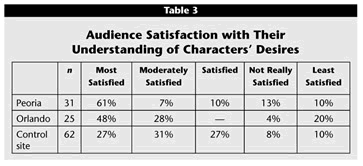
Click image for larger view.
The researchers also asked audience members "When actors addressed the cameras, how connected did you feel to them in the story?" This was an important difference because use of a screen automatically eliminates the ability to have actual human contact. Those experiencing the combination of interactive and technology overwhelmingly indicated they felt "very connected" or "connected," as shown in Table 4. Those in the control group (45 percent) indicated that they felt only "a little connected" or "not connected" to the actors.
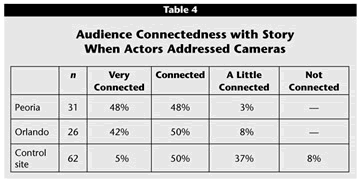
Click image for larger view.
Research results show that The Antigone Experiment succeeded in simple storytelling, but our data also indicate that enhanced technology works more effectively as a storytelling medium when combined with human interaction. The control group without live interaction scored the event lower in key areas, as displayed in Tables 1 through 4. Live actors in the interactive space enhanced audience perceptions of connection, understanding, and empathy with the story and characters. We believe this has enormous implications for anyone who wishes to communicate information to a group.
Figure 5 shows a scene taken from the DVD prepared for the control group. Creon in Thebes (Peoria) and Antigone in the last building left standing at the civil war battlefield (Orlando) face each other from "across the world." It does not look all that different from what you might see on national and international news services. As we continue to learn how we can better use our new technologies to communicate, it is important to remember what theater people have know for centuries: It is not just important that you transmit information—it is important that you connect to people. That will determine the effectiveness of your message.
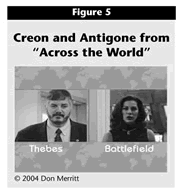
Click image for larger view.
Recommendations for Other Projects
We recommend clear discussion about partners’ goals early in the process. Answer the question "What does my partner need to feel successful at the end of this experiment?"
The Dynamic Media Project used existing infrastructures at UCF and Bradley with minimal modifications to facilitate our staging over Internet2. If your organizations have compatible preexisting equipment (see the sidebar), you can repeat our experiment at a low cost to the sponsoring institutions. We suggest you look for similar resources within your institution from the start.
We recommend clear communication between partners about organizational and logistical challenges because these are likely to differ for each partner. This will facilitate shared expectations during your creative process.
We recommend that you collaborate with someone you already know well. Our project leaders found that prior collaborations helped overcome "communication drift" and achieve greater efficiency.
We recommend the involvement of students and interdisciplinary faculty in your project. Student participation can be invigorating for the student and gives vitality to the project. In our project, students on both campuses enjoyed a unique experience. Interdisciplinary faculty involvement aided problem solving, provided multidisciplinary viewpoints, and ensured project success.
Benefits
One 49-year-old Bradley audience member wrote that his favorite part of the experiment was "the excitement of seeing … another university collaborate with our university. This rocks!" Anything that generates that kind of enthusiasm is a boon to the educational environment. To let others know about the project, we have presented our collected research at a number of national and international conferences and workshops (see the sidebar).
Another benefit to students is the potential for wider contact with professionals having the potential to improve their education. Long-distance workshops and long-distance arts projects can expand the opportunity to collaborate with artists without the requirement of time for travel or the cost of housing. Professionals can be brought in to work on projects without uprooting their lives or devoting their schedules exclusively to one project.
Because of our experience in long-distance arts collaboration, opportunities abound for future projects. UCF has discussed long-distance theater collaboration with the medical department of Catholica University in Santa Cruz, Bolivia, for example. Catholica needs case studies for their medical students, who as doctors will frequently treat American tourists having no knowledge of the Spanish language. UCF actors would play the "ailing tourists" to the benefit of both universities.
Bradley is in contact with the University of Waterloo in Ontario and in discussion with Shakespeare & Company in Lenox, Massachusetts. Waterloo is working on a series of "tele-performance" workshops that will culminate in an Internet2–Canarie Network production focused on the work of Samuel Beckett. Shakespeare & Company hopes to develop a long-distance classical acting training program via Internet2. Corporate and governmental training, the entertainment industry, and marketing could also benefit from expanding on this kind of live, interactive story-delivery medium. We believe that this and other interactive entertainment can be hugely effective at driving a paying public to a variety of events or in drawing attention to a particular product or industry.
We urge you to experience the possibilities of employing Internet2 for a multiform presentation at your school or university in collaboration with your students and partners. We believe that logistics and human communication will be your biggest challenges, not technology. Our experience indicates that experiments in a multiform environment can produce vigorous and worthwhile educational experiences that benefit students, faculty, and the institution while creating new opportunities for further exploration.
